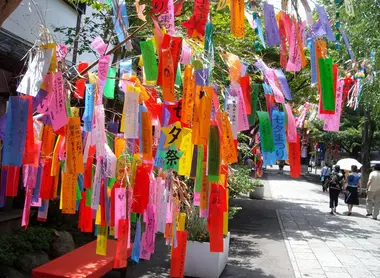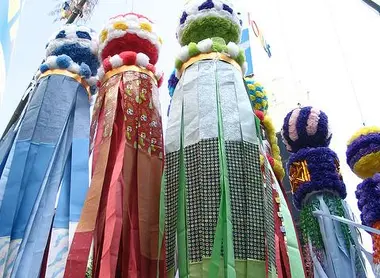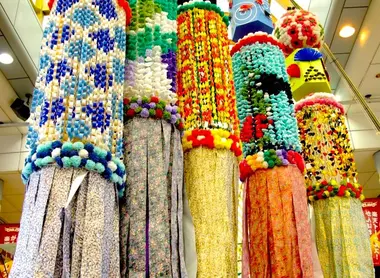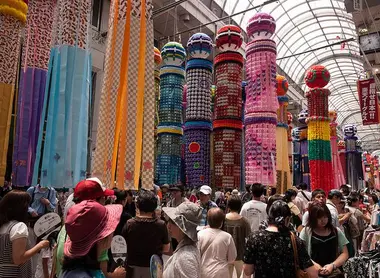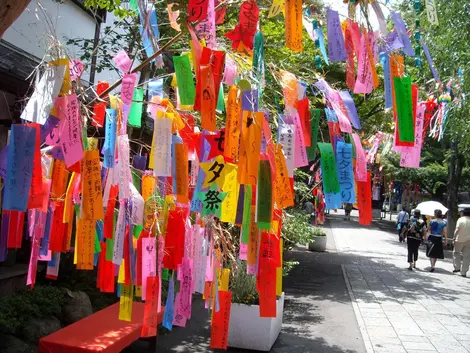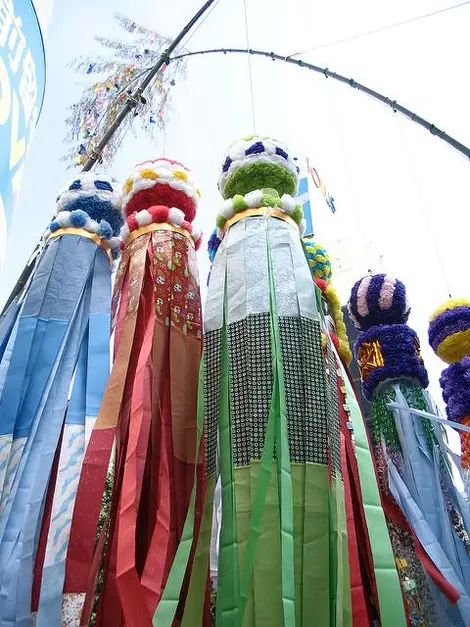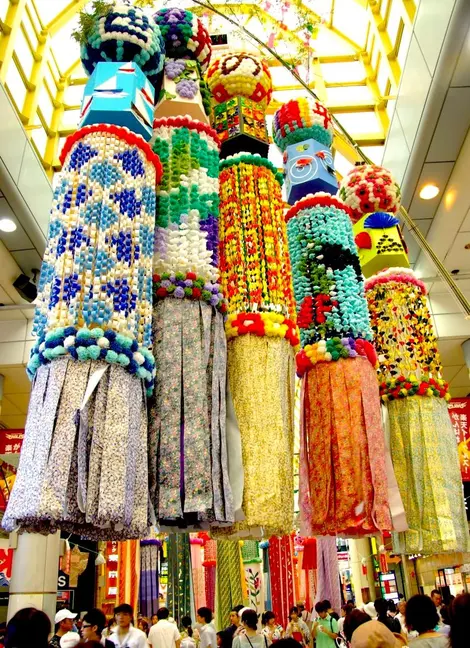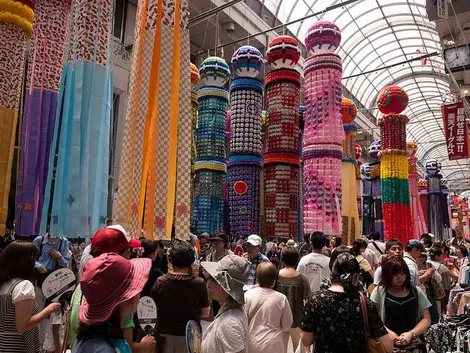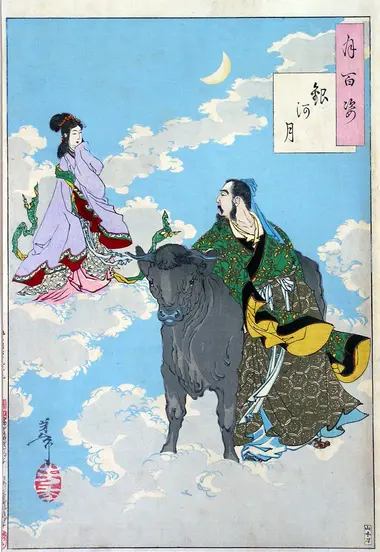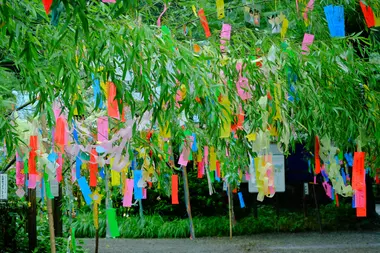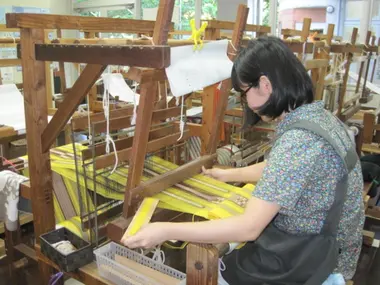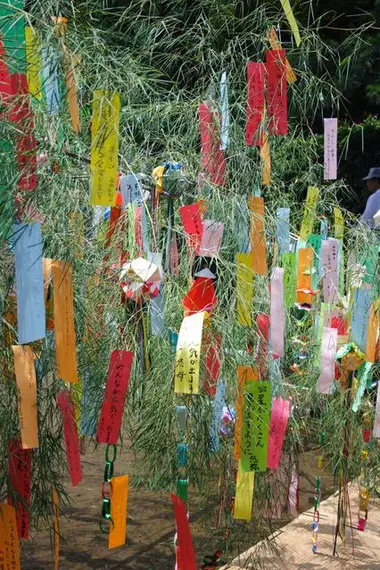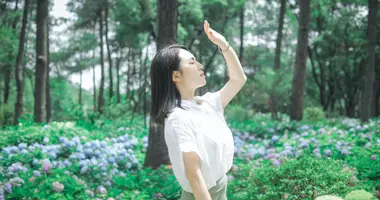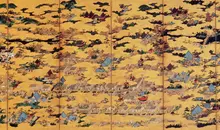The festival of Tanabata matsuri in Japan 七夕
- Pubblicato il : 29/04/2020
- Per : H.J. / I.D.O
- Youtube
Festival incontournable de l'été au Japon : La fête des étoiles de Tanabata
Vers le 7 juillet ou le 7 août, selon les régions, les Japonais célèbrent la fête des étoiles, lors du Tanabata matsuri, né de la fusion de légendes japonaise et chinoise. A cette période, le japon est égayé par des décorations colorées porteuses d'espoirs.
The Japanese version of Tanabata
It is said that in ancient Japan, between July 7 and 15 (date of the old lunar calendar, which corresponds to the beginning of August in the Gregorian calendar, practiced in Japan since 1872) the young villagers used to gather near a river to weave clothes for the souls of the dead which were celebrated on July 15 for The Obon period. To help souls find their way, the young peasant women, called for the occasion Tanabata-tsume "the girls who weave", Tanabata, designating an instrument for weaving with ideograms different from those of the Tanabata festival), hung the clothes they had woven on bamboo poles.
Another legend speaks of only one weaver, always named Tanabata-tsume, who offered the brocades she had woven to the spirits of the river during their annual visit to the feast of the dead, on the seventh evening of the seventh month.
- Read also: The Iriya Asagao festival in Tokyo
The Chinese legend of the herdsman and the weaver
To these versions of Japanese origin, was added the legend of the herdsman and the weaver, of Chinese origin, from which Japan imported (probably in the Nara era, 710-794) two slightly different versions, both linked to the stars Vega and Altair.
According to one of the versions, the seventh daughter of the God of Heaven (Tentei), was named Orihime "the weaver princess" (who, in legend, represents the star Vega), because she spent her days weaving magnificent brocades. One day, the latter decided to go visit Earth where she met Hikoboshi (Altair), "the star of the herdsman"), to whom she fell in love. They married and had two children. This displeased the God of heaven who sent a genie to seek his daughter to bring her back to him. Hikoboshi rushed after him, but Orihime's mother revealed a river, the Milky Way, and Hikiboshi was separated from his wife. From that day on, the two lovers did not stop crying, each on one side of the river. The God of Heaven moved, allowed them to meet once a year, on the seventh night of the seventh lunar month. Legend has it that that night, magpies (long-tailed crows) build a bridge over "the river of heaven" to allow the two spouses to meet.
In the second version, it was the God of heaven who introduced Hikoboshi, who lived on the other side of "the river of heaven", to his daughter Orihime. But the two loved each other so much that they neglected their respective tasks. Orihime stopped weaving and Hikoboshi abandoned his flock. Angered, the God of heaven decided that the two lovers could only meet once a year, on the seventh night of the seventh month.
In both versions, it is said that if it rains that night, the two spouses cannot meet and will have to wait until the following year, sadly.
To understand the astrological phenomenon of the stars Vega and Altair: 5 famous Japanese legends
In time, the legends of Tanabata became a festival celebrated all over Japan: Tanabata matsuri
During the Heian period (794-1185), young girls who wanted to work in weaving or sewing began to pray to the star Vega on the seventh day of the seventh lunar month. On an altar, they installed offerings and five needles on which were threaded silk threads in the colors of the five elements of Chinese cosmology: white for metal, red for fire, yellow for Earth, green or blue for wood, black for water.
Slowly the holiday was adopted by young girls who began to make vows to find a soul mate. And, since the Edo period (1603-1868), all Japanese, including adult males and children to make a wish on the evening of Tanabata, the belief is that the two lovers will grant wishes to all.
Tanabata (七夕) means " 7 evenings " and this feast is celebrated on the seventh evening of the seventh month, a date which varies depending on the Gregorian calendar or the lunar calendar: July 7 or August 7. on that evening, many Japanese people gaze the sky to watch the stars Vega and Altair approaching the Milky Way.
- Read also: Matsuri, Japanese festivals
Tanabata feast today
Today the star festival is distinguished by decorations made of bamboo branches (which recall the landmark role played by bamboo poles in the ancient tradition of Japan) on which the Japanese place tanzaku, small cards. vertical cardboard or colored paper on which they write a wish. Thus, they hope that the two stars will help achieve their wishes. We can see these colorful branches in houses or gardens, nurseries, schools, Shinto shrines but also some station halls and supermarkets.
Traditionally, the day after Tanabata, bamboo branches were burnt or thrown into the water to make wishes. Today, this custom is seldom followed and prohibited by the municipalities for safety and conservation.
It is customary for lanterns to be hung from bamboo trees in all streets (again, this refers to the markers that were set for the obon, (ancestral worship). Wearing the yukata, a light cotton kimono, is required when walking in the streets and courtyards of shrines.
- Read also: Yukata and jinbei, dressing for summer
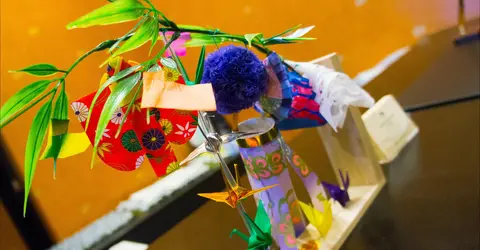
Les 7 ornements de Tanabata selon la tradition de Sendai, version miniature
Laura Tomas Avellana
Where to see the Tanabata festival?
More than a party, it is also decorations exhibited in private or public places and Shinto shrines. On the evening of Tanabata, it can be interesting to go to a shrine where tanzaku and bamboo branches are made available to the public to write and hang their wishes. We then see people apply themselves to writing their vows, most often in calligraphy. Moreover, during this festival, prayers are made so that the young girls improve their dexterity in calligraphy and crafts, recalling the wishes of the former future weavers.
In some cities, entire neighborhoods are decorated with huge multicolored poles (but more often than not paper tanzaku are replaced by colored plastic bands) and the party turns into dance performances, concerts, and other events. Not to mention the Yatai, (food stalls) where food and drinks are sold.
The unmissable Tanabata matsuri
Not far from Tokyo, the city of Hiratsuka is famous for its decorations and the Tanabata matsuri attracts thousands of visitors there every year.
